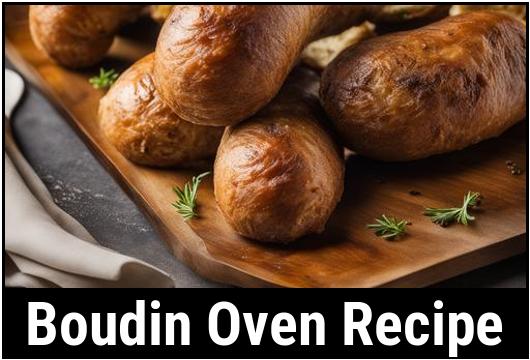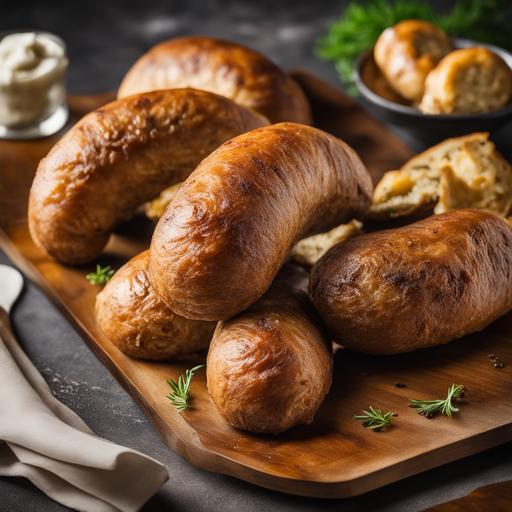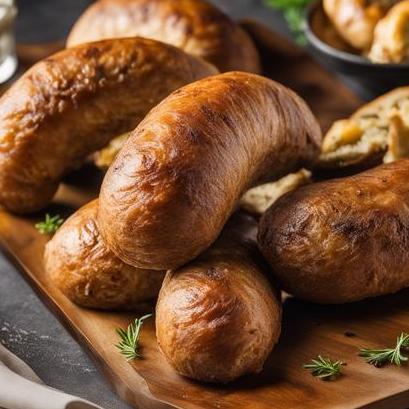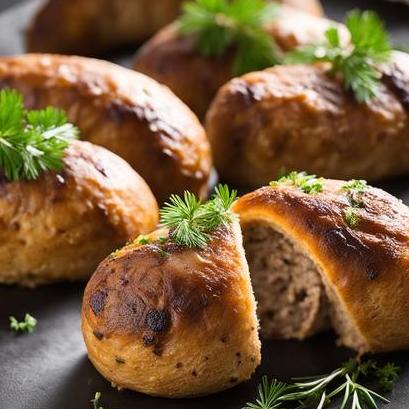
Boudin Oven Recipe: A Masterpiece Of Flavor And Texture
Boudin, a traditional Cajun dish originating from Louisiana, is a savory sausage made with pork, rice, onions, and a blend of herbs and spices. While it’s traditionally cooked by boiling or grilling, baking it in an oven offers a convenient and consistent method that yields delicious results. In this article, we’ll delve into the science behind cooking boudin in an oven, explore the key factors in ingredient selection and preparation, discuss the optimal oven temperature and timing, and finally, provide a detailed recipe for making boudin in the oven.
Food Science Of Cooking Boudin In An Oven
Cooking boudin in an oven involves a combination of dry and moist heat, resulting in a tender yet slightly crisp exterior and a juicy, flavorful interior. The oven’s dry heat helps to caramelize the outer layer of the sausage, creating a desirable texture and flavor profile. Additionally, the enclosed environment of the oven ensures even cooking throughout the boudin, preventing any parts from drying out or becoming overcooked.
The internal temperature reached during baking is crucial for food safety, ensuring that the pork in the boudin reaches a safe temperature to consume. According to USDA guidelines, pork should be cooked to an internal temperature of at least 145°F (63°C) to ensure it is safe to eat.
Choosing Ingredients
Selecting high-quality ingredients is essential for making delicious boudin. When choosing pork, opt for cuts with a good balance of lean meat and fat, such as pork shoulder or pork butt. The fat adds moisture and flavor to the sausage, while the lean meat provides structure.
For the rice component, long-grain white rice is traditionally used in boudin. This type of rice has a firm texture and holds its shape well during cooking, contributing to the overall consistency of the sausage.
Onions are a key flavoring ingredient in boudin, providing a sweet and aromatic base. Choose fresh, firm onions, and consider sautéing them before adding them to the sausage mixture to enhance their flavor further.
The selection of herbs and spices can vary depending on personal preference and regional variations. Common herbs and spices used in boudin include parsley, thyme, garlic, black pepper, and cayenne pepper. Experiment with different combinations to find the flavor profile that suits your taste.
Preparing Ingredients

Before assembling the boudin mixture, it’s essential to prepare the ingredients properly. Start by cooking the rice according to package instructions until it’s tender but still slightly firm. Drain any excess water and set the rice aside to cool.
Next, prepare the pork by trimming off any excess fat and cutting it into small cubes. Season the pork generously with salt, pepper, and any other desired herbs and spices. If using sausage casings, soak them in water to soften them before stuffing.
Dice the onions finely and sauté them in a skillet with a bit of oil until they are soft and translucent. Allow the onions to cool before adding them to the boudin mixture.
Once all the ingredients are prepared, combine the cooked rice, seasoned pork, sautéed onions, and herbs/spices in a large mixing bowl. Mix everything together thoroughly, ensuring that the flavors are evenly distributed throughout the mixture.
Optimal Oven Cooking Temperature & Timing
To achieve the perfect balance of texture and flavor, it’s essential to cook boudin at the right temperature and for the correct amount of time. Preheat your oven to 350°F (175°C) to ensure that it’s fully heated before adding the boudin.
Place the boudin sausages on a baking sheet lined with parchment paper or aluminum foil, leaving some space between each sausage to allow for even cooking. If using sausage casings, prick them with a fork to prevent them from bursting during baking.
Bake the boudin in the preheated oven for approximately 30-40 minutes, or until the sausages are golden brown and cooked through. To ensure that the pork reaches the recommended internal temperature of 145°F (63°C), use a meat thermometer inserted into the thickest part of the sausage.
Once the boudin is fully cooked, remove it from the oven and allow it to rest for a few minutes before serving. This allows the juices to redistribute throughout the sausage, resulting in a more flavorful and moist end product.
Boudin Oven Recipe
Ingredients
- 1 lb (450g) pork shoulder or pork butt, trimmed and cubed
- 1 cup long-grain white rice, cooked
- 1 onion, finely diced
- 2 cloves garlic, minced
- 2 tablespoons fresh parsley, chopped
- 1 teaspoon fresh thyme leaves
- 1/2 teaspoon black pepper
- 1/4 teaspoon cayenne pepper
- Salt, to taste
- Sausage casings (optional)
Instructions
- Preheat your oven to 350°F (175°C).
- In a large mixing bowl, combine the cooked rice, seasoned pork, diced onion, minced garlic, parsley, thyme, black pepper, cayenne pepper, and salt. Mix everything together until well combined.
- If using sausage casings, stuff the boudin mixture into the casings, ensuring that they are evenly filled.
- Place the boudin sausages on a baking sheet lined with parchment paper or aluminum foil, leaving some space between each sausage.
- Bake the boudin in the preheated oven for 30-40 minutes, or until golden brown and cooked through, with an internal temperature of 145°F (63°C).
- Once cooked, remove the boudin from the oven and allow it to rest for a few minutes before serving.
- Serve the boudin hot with your favorite condiments or sides, such as mustard, hot sauce, or coleslaw.
Baking boudin in the oven offers a convenient and foolproof method for preparing this classic Cajun dish. By understanding the science behind oven cooking, selecting high-quality ingredients, and following the optimal temperature and timing guidelines, you can create boudin that is flavorful, juicy, and perfectly cooked every time. Experiment with different herb and spice combinations to customize the flavor to your liking, and enjoy this delicious sausage with family and friends.
Doneness Checks

Boudin, pronounced "boo-dan," traces its origins to the Acadian region of Canada and has evolved into a beloved staple of Cajun cuisine in Louisiana. Traditional boudin consists of pork meat, pork liver, rice, onions, and a blend of Cajun spices stuffed into sausage casings. It’s a versatile dish that can be served as an appetizer, main course, or even incorporated into other recipes like boudin balls or boudin-stuffed chicken.
Baking boudin in the oven offers several advantages over other cooking methods. It provides even heat distribution, ensuring that the sausage cooks uniformly without the risk of burning or uneven cooking. Additionally, baking allows the flavors to meld together beautifully while minimizing the need for constant monitoring, making it an ideal cooking method for busy home cooks.
Determining when boudin is fully cooked is crucial to achieving the perfect texture and flavor. While the exact cooking time can vary depending on factors such as the size of the sausage and the oven temperature, there are several reliable methods for checking doneness:
1. Internal Temperature
Using a meat thermometer is the most accurate way to gauge the doneness of boudin. Insert the thermometer into the center of the sausage, avoiding contact with the casing or any rice grains. Boudin is safely cooked when it reaches an internal temperature of 160°F (71°C). This ensures that the pork is fully cooked and safe to eat.
2. Texture
Visual and tactile cues can also indicate whether boudin is done. Fully cooked boudin should have a firm texture, with the casing appearing crisp and golden brown. When gently pressed with a fork or tongs, the sausage should feel firm but not overly dense. Additionally, the rice grains inside should be tender and fully cooked.
3. Color
Another indicator of doneness is the color of the boudin. A properly cooked sausage will have a rich, golden-brown hue on the exterior, signaling that it has caramelized evenly during baking. Avoid removing boudin from the oven until it achieves this desired color.
Undercooking
While undercooking boudin poses health risks due to insufficiently cooked pork, it can also result in unpleasant textures and flavors. Common signs of undercooked boudin include:
- Pinkish Hue: If the pork inside the sausage still appears pink or raw, it’s a clear indication that it needs more time in the oven.
- Soggy Texture: Undercooked boudin may have a mushy or soggy texture, particularly in the rice component. Properly cooked boudin should have a firm, cohesive texture.
- Unpleasant Odor: Raw pork has a distinct odor that is different from fully cooked meat. If the boudin emits a raw or unpleasant smell, it likely needs more time to cook.
If you suspect that your boudin is undercooked, return it to the oven and continue baking until it reaches the recommended internal temperature of 160°F (71°C).
Overcooking
Overcooking boudin can lead to dry, tough sausage with diminished flavors. While it’s essential to ensure that the pork is thoroughly cooked for food safety reasons, it’s equally crucial to avoid prolonged cooking times that can result in overdone boudin. Signs of overcooked boudin include:
- Dry Texture: Overcooked boudin may have a dry, crumbly texture, with the meat and rice appearing overly cooked.
- Burnt Casing: Excessive baking can cause the casing to become overly crisp or even burnt, detracting from the overall taste of the sausage.
- Loss of Flavor: Extended cooking times can diminish the flavors of the spices and ingredients in the boudin, resulting in a less vibrant and enjoyable eating experience.
To prevent overcooking, monitor the boudin closely during the baking process and remove it from the oven as soon as it reaches the recommended internal temperature of 160°F (71°C). Additionally, consider covering the boudin with aluminum foil halfway through the baking time to prevent excessive browning.
Troubleshooting

Despite your best efforts, you may encounter challenges when baking boudin in the oven. Here are some common issues and troubleshooting tips:
1. Uneven Cooking
If you notice that the boudin is cooking unevenly, with some portions browning more quickly than others, rotate the sausages halfway through the baking time. This ensures that all sides are exposed to the heat evenly, promoting uniform cooking.
2. Excessive Browning
If the boudin is browning too quickly on the outside while the interior is still undercooked, cover the sausages loosely with aluminum foil. This will prevent the casing from burning while allowing the interior to continue cooking through.
3. Dry Texture
To remedy dry or overcooked boudin, try serving it with a flavorful sauce or gravy to add moisture and enhance the overall taste. Alternatively, slice the boudin and incorporate it into dishes like jambalaya or gumbo, where the moisture from the other ingredients can help to rehydrate the sausage.
4. Raw Rice
If the rice inside the boudin remains undercooked even after the sausage reaches the proper internal temperature, it may be due to insufficient moisture or inadequate cooking time. Consider adding a bit of chicken broth or water to the baking dish before returning the boudin to the oven, and continue baking until the rice is tender.
Recipe Variations
While traditional boudin is delicious on its own, there are countless ways to customize the recipe to suit your taste preferences. Here are some popular variations to consider:
1. Seafood Boudin
Swap out some or all of the pork in the boudin recipe for shrimp, crabmeat, or crawfish to create a flavorful seafood version of this classic dish. Add Cajun seasoning and minced vegetables like bell peppers and celery for a true taste of Louisiana.
2. Vegetarian Boudin
For a meat-free alternative, omit the pork and replace it with cooked lentils, mushrooms, or a blend of vegetables like carrots, onions, and bell peppers. Season generously with Cajun spices and herbs for a vegetarian twist on boudin that’s packed with flavor.
3. Spicy Boudin
Kick up the heat by adding extra Cajun seasoning, cayenne pepper, or hot sauce to the boudin mixture. For an extra fiery kick, incorporate diced jalapeños or habanero peppers into the sausage filling. Serve with a side of cooling coleslaw or ranch dressing to balance out the heat.
4. Smoked Boudin
For a smoky flavor infusion, cook the boudin on a smoker instead of baking it in the oven. This method adds depth and complexity to the dish, with the subtle notes of wood smoke complementing the savory flavors of the sausage.
Baking boudin in the oven is a convenient and foolproof way to enjoy this quintessential Cajun delicacy at home. By following the guidelines outlined in this comprehensive guide, you can ensure that your boudin turns out perfectly cooked every time, with a golden-brown exterior, tender interior, and rich, flavorful filling. Whether you stick to the traditional recipe or experiment with creative variations, baking boudin in the oven is sure to delight your taste buds and transport you to the vibrant culinary landscape of Louisiana.
Flavour Enhancement Tips
Boudin is a staple in Cajun cuisine, with its origins dating back to the 18th century in Louisiana. Traditionally made with pork meat, pork liver, rice, onions, and seasonings such as garlic, cayenne pepper, and thyme, boudin is a flavorful sausage with a unique combination of savory, spicy, and earthy notes.
Cooking boudin in the oven offers several advantages over other methods. It allows for even cooking without the need for constant monitoring, and it produces a moist and tender texture while preserving the flavors of the ingredients. Additionally, baking boudin eliminates the need for excess oil, resulting in a healthier dish.
To enhance the flavor of your boudin, consider incorporating the following tips:
1. Seasoning Blend
- Use a well-balanced seasoning blend that includes salt, pepper, garlic powder, onion powder, paprika, and cayenne pepper for a traditional Cajun flavor profile.
- Experiment with additional herbs and spices such as thyme, oregano, and bay leaves to customize the seasoning to your taste preferences.
2. Sautéed Vegetables
- Sauté onions, bell peppers, and celery before mixing them into the boudin mixture. This step helps release their natural sweetness and adds depth to the overall flavor.
3. Pork Fat
- Incorporate pork fat into the boudin mixture for added richness and moisture. This can be achieved by using fatty cuts of pork or adding rendered pork fat to the mixture.
4. Liquid Seasonings
- Add liquid seasonings such as Worcestershire sauce, hot sauce, or soy sauce for an extra layer of flavor. These ingredients provide depth and complexity to the boudin.
Texture Enhancement Tips

Achieving the perfect texture is essential for a satisfying boudin experience. Follow these tips to enhance the texture of your baked boudin:
1. Rice Consistency
- Cook the rice until it is tender but still slightly firm. Overcooked rice can become mushy and compromise the texture of the boudin.
2. Meat-to-Rice Ratio
- Maintain a balanced ratio of meat to rice in the boudin mixture. Too much rice can make the boudin dry, while too much meat can result in a dense and heavy texture.
3. Moisture Retention
- Ensure that the boudin mixture is adequately moist by adding broth, stock, or water as needed. Moisture helps bind the ingredients together and prevents the boudin from drying out during baking.
4. Casing Integrity
- Use high-quality sausage casings and secure them tightly to prevent the boudin mixture from leaking during baking. Properly sealed casings help maintain the shape and texture of the boudin.
Cooking At Different Temperatures
Baking boudin in the oven allows for flexibility in cooking temperatures, depending on your desired outcome. Here’s how to adjust the temperature for different texture and flavor profiles:
1. Low And Slow (300°F/150°C)
- Baking boudin at a low temperature for an extended period results in a tender and moist texture with deep, caramelized flavors. This method is ideal for achieving a rich and succulent boudin.
2. Moderate Heat (350°F/175°C)
- Baking boudin at a moderate temperature produces a balanced texture with crispy casing and moist filling. This method allows for even cooking without drying out the boudin.
3. High Heat (400°F/200°C)
- Baking boudin at a high temperature yields a crispy exterior with a juicy interior. This method is perfect for achieving a golden brown crust while maintaining a soft and flavorful center.
Cooking Tips
To ensure success when baking boudin in the oven, follow these essential cooking tips:
1. Preheat The Oven
- Preheat your oven to the desired temperature before placing the boudin inside. This ensures even cooking and helps prevent the boudin from sticking to the pan.
2. Arrange Properly
- Place the boudin links on a baking sheet or in a baking dish, making sure they are spaced apart evenly to allow for air circulation. Avoid overcrowding, as this can result in uneven cooking.
3. Monitor Doneness
- Check the internal temperature of the boudin using a meat thermometer to ensure it reaches a safe minimum temperature of 160°F (71°C). Cooking times may vary depending on the size and thickness of the boudin links.
4. Rest Before Serving
- Allow the baked boudin to rest for a few minutes before serving to allow the juices to redistribute and the flavors to develop. This step helps ensure a moist and flavorful end result.
Serving Suggestions
Baked boudin is a versatile dish that can be enjoyed in various ways. Here are some serving suggestions to inspire your culinary creativity:
1. Traditional Plate
- Serve baked boudin alongside classic Cajun sides such as red beans and rice, collard greens, or cornbread for a hearty and satisfying meal.
2. Appetizer Platter
- Slice baked boudin into bite-sized pieces and serve them on a platter with dipping sauces such as Creole mustard, remoulade, or hot sauce for a flavorful appetizer.
3. Boudin Po’ Boy
- Stuff baked boudin into a French bread baguette and top it with shredded lettuce, sliced tomatoes, and pickles for a delicious and filling sandwich.
4. Boudin Breakfast
- Serve baked boudin alongside eggs, grits, and biscuits for a hearty and flavorful breakfast or brunch option.
Conclusion
Baking boudin in the oven is a convenient and delicious way to enjoy this classic Cajun sausage. By following the flavor and texture enhancement tips, adjusting cooking temperatures, and implementing essential cooking tips, you can achieve a perfect boudin dish that is moist, flavorful, and satisfying. Whether served as a main course, appetizer, or breakfast dish, baked boudin is sure to delight your taste buds and impress your guests with its rich flavors and tender texture. Experiment with different seasoning blends and serving variations to customize your boudin experience and discover new culinary delights.
FAQS
What Is Boudin?
Boudin is a Cajun dish made from a mix of meats, such as pork, liver, and rice, that are blended with herbs and spices and then stuffed into a sausage casing.
Can I Use An Oven To Cook Boudin?
Yes, an oven is a great alternative way to cook boudin if you do not have access to a stovetop or a grill.
What Temperature Should The Oven Be Set To For Cooking Boudin?
The oven should be preheated to 375°F (190°C) for cooking boudin.
How Long Should Boudin Be Cooked In The Oven?
Boudin should typically be cooked for 45 minutes to 1 hour in the oven, depending on the size and thickness of the boudin.
How Do I Know When Boudin Is Fully Cooked In The Oven?
The internal temperature of boudin should reach a minimum of 165°F (74°C) when fully cooked. You can also check by cutting into the boudin and ensuring that the filling is cooked and the exterior is crispy.


